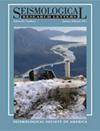Development of the Taiwan Generic Rock Seismic Velocity Profile
IF 2.6
3区 地球科学
Q2 GEOCHEMISTRY & GEOPHYSICS
引用次数: 1
Abstract
Reference velocity profiles for ground-motion models (GMMs) provide more information about the site condition represented by the GMM than the simple site parameters used in the GMMs, such as VS30 (time-averaged S-wave velocity of top 30 m strata from the surface). A reference velocity profile for generic soft-rock site conditions is developed for Taiwan using multiple data sets to span the depth range from 0 to 16 km. The measured VS profiles from PS-logging at strong-motion stations with VS30 between 610 and 930 m/s (i.e., 760 m/s ± 20%) were selected to define the top 30 m of the profile. The velocity profiles obtained from multiple existing geophysical studies were then used to extend the VS profile to seismic bedrock (VS of 3.5 km/s). A corresponding generic rock P-wave velocity (VP) profile was developed using VP from PS-logging measurements and an empirical relationship between VP and VS for the deeper part of the profile. The proposed Taiwan Generic Rock (TWGR) model has VS30 of 754 m/s, Z1.0 (thickness of sediments with VS<1.0 km/s) of 29 m, Z2.5 (thickness of sediments with VS<2.5 km/s) of 2.1 km, and κ0 (spectral decay slope) of 0.052 s. The VS values of the TWGR profile at depths of 50 m–8 km are smaller than from the generic rock profile with VS30=760 m/s for California, which lead to different site amplifications between soft-rock sites in Taiwan and California. The TWGR provides information on the applicability of the large empirical data set of strong-motion recordings from Taiwan to other regions.台湾一般岩石地震速度剖面的发展
地面运动模型(GMMs)的参考速度剖面比GMMs中使用的简单场地参数(如VS30(距地表30米地层的时间平均横波速度))提供了更多关于GMM所代表的场地条件的信息。利用多个数据集,从0到16公里的深度范围内,为台湾开发了一般软岩场地条件的参考速度剖面。强震台站ps测井实测VS剖面,选择VS30在610 ~ 930 m/s之间(即760 m/s±20%),确定剖面的前30 m。然后使用从多个现有地球物理研究中获得的速度剖面将VS剖面扩展到地震基岩(VS为3.5 km/s)。利用ps测井测量的VP以及剖面深部VP和VS之间的经验关系,建立了相应的一般岩石纵波速度(VP)剖面。提出的台湾通用岩(TWGR)模型的VS30为754 m/s, Z1.0 (VS<1.0 km/s的沉积物厚度)为29 m, Z2.5 (VS<2.5 km/s的沉积物厚度)为2.1 km, κ0(光谱衰减斜率)为0.052 s。TWGR剖面在50 m ~ 8 km深度处的VS值小于加利福尼亚的一般岩石剖面(VS30=760 m/s),这导致台湾和加利福尼亚软岩站点之间的站点放大不同。TWGR提供了台湾强震记录的大型经验数据集在其他地区的适用性信息。
本文章由计算机程序翻译,如有差异,请以英文原文为准。
求助全文
约1分钟内获得全文
求助全文
来源期刊

Seismological Research Letters
地学-地球化学与地球物理
CiteScore
6.60
自引率
12.10%
发文量
239
审稿时长
3 months
期刊介绍:
Information not localized
 求助内容:
求助内容: 应助结果提醒方式:
应助结果提醒方式:


